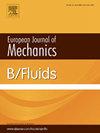Investigation of turbulent high-speed flow over the double wedge at varying aft-wedge deflections
IF 2.5
3区 工程技术
Q2 MECHANICS
引用次数: 0
Abstract
This study examines the shock–shock (SSI) and shock-wave boundary layer (SBLI) interaction mechanisms over the two-dimensional double wedge exposed to hypersonic Mach 5 flow. Several Unsteady Reynolds-averaged Navier Stokes (URANS) based turbulence models are used systematically to determine the most suitable model. Grid sensitivity analysis indicates that while the laminar model is sensitive to grid size, turbulent models exhibit grid independence, suggesting the laminar model’s unsuitability under these conditions. We further support this hypothesis by a qualitative and quantitative comparison of the numerical schlieren images and mean wall heat flux profiles, respectively, with the experimental results. The average heat flux based on the fully laminar assumption provides accurate predictions in the well-attached flow region, but it fails horribly after the SBLI interaction. The models using the standard SST (shear stress transport) turbulence model and the four-equation Lantry–Menter correlation-based model consistently overpredict the wall heat transfer rate throughout the double-wedge surface. The newly employed Krause correlations significantly improve the match with the qualitative and quantitative experimental observations. This article further uses this novel turbulence model to explore the impact of the aft-wedge angle variation () on the shock–shock interaction mechanisms and the associated wall properties. Results indicate a weak Edney type-V interaction at the lowest angle, transitioning to Edney type-V with Mach reflection for . Hence, the critical transition aft-wedge angle concerning the change in the shock interference pattern is between and .
双楔在不同楔后挠度下的湍流高速流动研究
本文研究了在高超声速5马赫流动条件下二维双楔上的激波-激波(SSI)和激波边界层(SBLI)相互作用机制。系统地使用了几种基于非定常reynolds -average Navier - Stokes (URANS)的湍流模型来确定最合适的模型。网格敏感性分析表明,层流模式对网格大小敏感,而湍流模式对网格无关,表明层流模式在这些条件下不适合。通过将数值纹影图像和平均壁面热流密度曲线分别与实验结果进行定性和定量比较,我们进一步支持了这一假设。基于完全层流假设的平均热流密度在良好附著流区有较好的预测效果,但在SBLI相互作用后,平均热流密度的预测效果很差。使用标准的k−ω SST(剪切应力输运)湍流模型和基于四方程的Lantry-Menter相关模型的模型一致高估了整个双楔表面的壁面换热率。新采用的克劳斯相关性显著提高了与定性和定量实验观察的匹配度。本文进一步利用这一新的湍流模型探讨了后楔角变化(450≤θ2≤600)对激波-激波相互作用机制和相关壁面特性的影响。结果表明,在最低角处存在微弱的Edney - v型相互作用,在θ2≥500时向Edney - v型相互作用过渡。因此,激波干涉图样变化的临界楔后过渡角在θ2=450和θ2=500之间。
本文章由计算机程序翻译,如有差异,请以英文原文为准。
求助全文
约1分钟内获得全文
求助全文
来源期刊
CiteScore
5.90
自引率
3.80%
发文量
127
审稿时长
58 days
期刊介绍:
The European Journal of Mechanics - B/Fluids publishes papers in all fields of fluid mechanics. Although investigations in well-established areas are within the scope of the journal, recent developments and innovative ideas are particularly welcome. Theoretical, computational and experimental papers are equally welcome. Mathematical methods, be they deterministic or stochastic, analytical or numerical, will be accepted provided they serve to clarify some identifiable problems in fluid mechanics, and provided the significance of results is explained. Similarly, experimental papers must add physical insight in to the understanding of fluid mechanics.

 求助内容:
求助内容: 应助结果提醒方式:
应助结果提醒方式:


